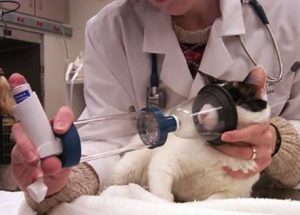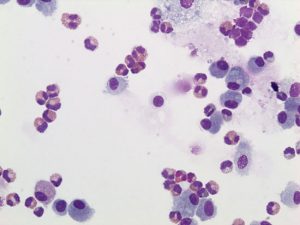 What is feline asthma?
What is feline asthma?
Feline asthma is a common cause of lower airway disease with signs beginning in young to middle age cats. The disease is triggered by breathing in environmental particles that trigger an allergic reaction. Once these allergens are inhaled, they are recognized by the immune system and inflammation begins. Inflammatory cells are recruited to the airway and produce chemicals that make the inflammation even worse. This vicious cycle leads to more and more inflammation. With more inflammation comes more disease. This excessive inflammatory response leads to narrowing of the airway, allergic airway inflammation, and eventually to structural changes to the airways themselves, all of which are hallmark findings in patients with asthma.
What do cats with asthma look like?
The most likely symptom that you will notice if your cat develops asthma is a cough. It may also have an increased breathing rate or difficulty breathing. The severity of signs is highly variable between pets, and variable over time. Some cats may even require immediate medical attention for a sudden onset of open mouth breathing, increased breathing rate, or increased breathing effort. Most commonly, your cat may have intermittent cough but appear normal between episodes. Coughing can be difficult to notice in cats and is often mistaken for hacking up hairballs. Your veterinarian may notice that your cat has an increased breathing rate and wheezes when it exhales. The inconsistency in signs makes diagnosis of asthma nearly impossible without taking into account your cat’s history, along with examination and diagnostic test findings.
How is feline asthma diagnosed?
It can be difficult for your veterinarian to notice any abnormalities with your cat because it can appear healthy in between episodes of coughing.
Your veterinarian will perform several tests before making a diagnosis. Feline asthma is like a complicated puzzle: The entire image cannot be seen until all the puzzle pieces are in place. Each diagnostic test is like a puzzle piece, no one piece can be used to diagnose asthma but when the pieces are assembled, all of the test results together complete the picture of feline asthma to make the diagnosis.
- A complete blood count, chemistry, and urinalysis are typically performed as the first round of diagnostic tests to help look for diseases of major organs. In asthmatic cats that are otherwise healthy, these tests are usually unremarkable. Occasionally an increased number of allergic immune cells (eosinophils) are measured in the blood.
- Fecal examinations and heartworm tests may also be performed since parasites can mimic asthma.
- Chest x-rays are used to get a two-dimensional view of the lungs. The lungs of asthmatic cats can vary in appearance from normal to severely inflamed with lung lobe and airway collapse. Such findings on an x-ray can suggest feline asthma.
- A computed tomography (CT) scan of the chest can be used to construct a three-dimensional view of the lungs. Like chest x-rays, chest CT scans help highlight structural changes in the lung. Unlike x-rays, chest CT scans provide a more comprehensive view of the entire lung in three-dimensional space. Findings such as airway wall thickening and airway collapse are suggestive for asthma. Importantly, other disorders that mimic features of asthma, but have different prognoses and treatments, may become evident on CT evaluation.
- A bronchoscopy is a procedure that allows the veterinarian to look inside the airways directly with a small camera. After the cat is put under general anesthesia, a camera on a thin flexible rod is inserted into its mouth, down the windpipe, and into the lower airways. The camera is controlled with a joystick to look around the airway in all directions. Evidence of redness, irritation, airway collapse, airway narrowing, and mucus accumulation is common. Similar to chest x-ray and CT scan findings, these findings alone are not diagnostic of asthma.
- A bronchoalveolar lavage cytology and culture are performed during a bronchoscopy to better understand the cells and bacteria within the airway that might be causing disease. A bronchoalveolar lavage is performed by flushing a small volume of sterile salt water into the airway and sucking the fluid back out through the bronchoscope or through a catheter. In asthmatic cats, a high percentage of allergic immune cells (eosinophils) can be seen under a microscope in samples of fluid from the airway. To determine whether or not a bacterial infection is present in the lung, the fluid sample may also be cultured.
It is important to emphasize that there is no single best test for this disease. The diagnosis must be made after considering your cat’s past medical history, symptoms and test results.
How is feline asthma treated?
The goal of asthma treatment is to help your cat breathe better. If your cat is in respiratory distress, it may need to stay at the hospital in an oxygen cage. An oxygen cage is a sealed chamber that contains a higher amount of oxygen compared to room air. More oxygen will help your cat breathe and help resolve its respiratory distress. It may need to stay in oxygen for a few days until it is comfortable breathing room air again.

Properly administering inhaled steroids to your cat requires a special inhaler. Inhalers for cats are designed to ensure that your pet receives its medication.
Once a diagnosis is made, treatment with medicine is begun immediately in the hospital and continued at home. To help medically manage asthma, drugs are used to reduce airway inflammation and constriction, helping your cat breathe better.
- Oral steroids, such as prednisolone, can be given as a pill or liquid by mouth once daily. This medication can be mixed with canned wet cat food or hidden in a treat to make medicating your cat easier. Unfortunately, topical steroids are not helpful.
- Inhaled steroids can be delivered through the nose as your cat breathes in. Special inhalers, such as the Aerokat Feline Aerosol Chamber, are used to treat cats with asthma. When a cat breathes in, high doses of the steroid medication directly contact the airway where they exert a local anti-inflammatory effect.
- Bronchodilators are used to decrease airway constriction. There are many types of bronchodilators that work in different ways. These drugs can be administered to cats in respiratory distress through an injection, pill or by using an inhaler. These drugs are most important as emergency treatments, but severely affected cats may require them at home too.
Either inhaled steroids or oral steroids are used to control your cat’s asthma long-term. Bronchodilators are not used alone to control asthma because they merely prevent airway constriction and do not control the inflammatory response to environmental allergens that causes disease.

Bronchoalveolar lavage fluid from asthmatic cats typically contain excessive eosinophils. These cells contain pink-staining granules that are released during inflammation and cause damage to the airways.
Minimizing exposure to environmental allergens
Helping to decrease your cat’s exposure to allergens can be helpful. Decreasing their exposure to airborne chemicals, such as smoke, perfumes and sprays, is critical to avoid airway irritation. Environmental modification should be used in conjunction with long-term medications. Allergy testing can be used to help determine which specific allergens are most problematic for your cat.
- Blood antibody testing can be done to quantify the body’s immune response to certain allergens. If your cat has high levels of IgE (allergy) antibodies against a particular allergen, such as grasses, this suggests that those grasses may cause symptoms.
- Intradermal allergy testing (IDAT) exposes your cat to known amounts of allergens underneath the skin and measures the immune response, much like a human skin allergy test.
Both blood allergy testing and the IDAT can be used to determine your cat’s unique allergies. With this knowledge you can modify your cat’s environment and minimize exposure to allergens, helping to improve overall health.
Life after the diagnosis
The prognosis following diagnosis is dependent on the severity of your cat’s asthma and its response to medical management. If inflammation within the lungs continues to go unchecked or uncontrolled, damage to the airway becomes permanent and can interfere with your cat’s quality of life. In fact, asthma can be fatal. Fortunately, most cats respond well to medical management. With proper care and follow-up, most asthmatic cats can live a long and healthy life.
Written by Kari Deininger, MU CVM Class of 2017
Edited by Leah Cohn, DVM, PhD, DACVIM and Megan Grobman, DVM, MS



